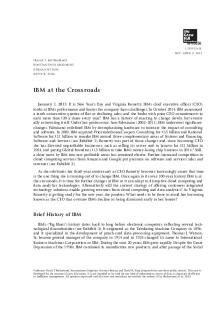IBM Lecture 1 PDF

| Title | IBM Lecture 1 |
|---|---|
| Course | Introduction to Business and Management |
| Institution | University of Sussex |
| Pages | 2 |
| File Size | 59.3 KB |
| File Type | |
| Total Downloads | 38 |
| Total Views | 127 |
Summary
IBM Lecture 1...
Description
Lecture 1 – Management Activity 2 November 2020 10:46 PM
Sulitest:
Sustainability award Raise awareness, develop and assess knowledge of UN’s SDG’s and CSR among students, stakeholders etc. Sulitest accreditation – employees look for at interviews
Definition: organisation and coordination of the activities of a business in order to achieve defined aims History:
Originates from class systems – capital owning classes dominated the workforce of the lower working class Taylor thought it was possible to measure a worker’s daily output and set wage rates accordingly.
What is management?:
Drucker’s (2001) five-point guideline: Making strengths effective and weaknesses irrelevant Enhancing people’s contributions Integrating people in a common venture through values and goals Grow and develop the enterprise Ensuring everyone knows their expectations Mintzberg’s (1989) basic principles Ensure efficient production Maintain stability of operations Adapt to changing environments Ensure the organisation servers its purpose Serve as a key link between organisation and environment Operate the organisation’s status system
Is management a science or an art?: Science Methods and principles Concepts Theories Systemic method to find a possible solution Organised knowledge Practice Art Organises and uses human talent Practical knowledge
Personal skill Creativity Perfection through practice Goal-oriented
Management Models Fayol suggests managers have 6 roles: Plan Organise Command Lead Coordinate Control His work was ignored – only after his death he gained recognition To be an effective manager you need to meet 14 principles Division of work
Discipline
Interest
Order
Initiative
Authority of responsibility
Unity of command
Remuneration
Equity
Esprit de corp
Unity of direction
Centralisation
Scalar chain
Stability of tenure
these are okay in simple/stable conditions not enough in complex and dynamic times Katz – Three Skills Approach: Different managers at different levels need different types of skills Skills can be taught, and managers and leaders can be trained Person-centric approach Mintzberg’s Management Role Taxonomy: 6 characteristics that defined working lives of managers Open ended workload Start own actions Work in varied/fragmented roles Preferred to avoid reported info Preferred verbal communication Maintain relationships with subordinates Identified 10 roles in 3 groups Interpersonal roles: figure head, leader, liason Informational roles: monitor, disseminator, spokesperson Decisional roles: entrepreneur, disturbance handler, resource allocator, negotiator New Public Management: Aim to give more public sector more choice over which service contractors to use Attempts to make public server more efficient Received a lot of managers but became top heavy and inefficient...
Similar Free PDFs

IBM Lecture 1
- 2 Pages

Angielski - ibm
- 4 Pages

IBM Case Study
- 45 Pages

IBM SWOT - Professor Flemming
- 33 Pages

Manual IBM SPSS
- 19 Pages

IBM at The Crossroads
- 22 Pages

IBM - case study
- 4 Pages

Lenovo -IBM Merge
- 3 Pages

Cost of Capital - IBM
- 5 Pages

IBM Credit Corporation
- 9 Pages

ARSITEKTUR IBM SERVER
- 11 Pages

BQ1031exercises on ibm handon
- 90 Pages

IBM 3072 Midterm - Anthony Vercillo
- 10 Pages
Popular Institutions
- Tinajero National High School - Annex
- Politeknik Caltex Riau
- Yokohama City University
- SGT University
- University of Al-Qadisiyah
- Divine Word College of Vigan
- Techniek College Rotterdam
- Universidade de Santiago
- Universiti Teknologi MARA Cawangan Johor Kampus Pasir Gudang
- Poltekkes Kemenkes Yogyakarta
- Baguio City National High School
- Colegio san marcos
- preparatoria uno
- Centro de Bachillerato Tecnológico Industrial y de Servicios No. 107
- Dalian Maritime University
- Quang Trung Secondary School
- Colegio Tecnológico en Informática
- Corporación Regional de Educación Superior
- Grupo CEDVA
- Dar Al Uloom University
- Centro de Estudios Preuniversitarios de la Universidad Nacional de Ingeniería
- 上智大学
- Aakash International School, Nuna Majara
- San Felipe Neri Catholic School
- Kang Chiao International School - New Taipei City
- Misamis Occidental National High School
- Institución Educativa Escuela Normal Juan Ladrilleros
- Kolehiyo ng Pantukan
- Batanes State College
- Instituto Continental
- Sekolah Menengah Kejuruan Kesehatan Kaltara (Tarakan)
- Colegio de La Inmaculada Concepcion - Cebu


